Key points How does the diagnostic performance of home antigen tests change during the course of SARS-CoV-2 infection? Findings In this prospective cohort study of 225 adults and children with SARS-CoV-2 infection confirmed by reverse transcription-polymerase chain reaction (RT-PCR), the sensitivity of the antigen test was 64% and 84%. % compared to same-day RT-PCR and viral culture, respectively. Antigen test sensitivity peaked 4 days after illness onset (77%); a second test 1 to 2 days later showed improved sensitivity (81%-85%). Meaning Study results suggest that symptomatic people with an initial negative home antigen test result for SARS-CoV-2 infection should be tested again 1 to 2 days later because the sensitivity of the test appears to peak. maximum several days after the onset of the illness. |
Importance
As self-collected home antigen tests become widely available, a better understanding of their performance during the course of SARS-CoV-2 infection is needed.
Aim
To evaluate the diagnostic performance of home antigen tests compared to reverse transcription-polymerase chain reaction (RT-PCR) and viral culture by days from illness onset, as well as user acceptability.
Design, environment and participants
This prospective cohort study was conducted from January to May 2021 in San Diego County, California, and the Denver, Colorado metropolitan area. The convenience sample included adults and children with RT-PCR-confirmed infection who used self-collected home antigen tests for 15 days and underwent at least 1 nasopharyngeal swab for RT-PCR, viral culture, and sequencing.
Exhibitions
SARS-CoV-2 infection.
Main results and measures
The primary outcome was the daily sensitivity of home antigen tests to detect cases confirmed by RT-PCR. Secondary outcomes included the daily percentage of positive antigen test, RT-PCR, and viral culture results, and the sensitivity of the antigen test compared to same-day RT-PCR and cultures. Antigen test use errors and acceptability were assessed for a subset of participants.
Results
This study enrolled 225 people with RT-PCR-confirmed infection (median [range] age, 29 [1-83] years; 117 participants female [52%]; 10 [4%] Asian, 6 [3%] Black or African) Americans, 50 [22%] Hispanic or Latino, 3 [1%] Native Hawaiian or other Pacific Islander, 145 [64%] white, and 11 [5%] multiracial) who completed 3,044 antigen tests and 642 nasopharyngeal swabs.
The sensitivity of the antigen test was 50% (95% CI, 45%-55%) during the infectious period, 64% (95% CI, 56%-70%) compared to RT-PCR of the same day and 84% (95% CI, 75%-90%) compared to same-day cultures.
The sensitivity of the antigen test peaked 4 days after illness onset at 77% (95% CI, 69%-83%).
The sensitivity of the antigen test was improved with a second antigen test 1 or 2 days later, particularly early in infection. Six days after illness onset, the positivity of the antigen test result was 61% (95% CI, 53%-68%).

A, Daily sensitivity of 3 home antigen testing protocols; the reference standard was a positive reverse transcription-polymerase chain reaction (RT-PCR) test at any time during the investigation. B, Daily difference in test protocol sensitivities. For protocols 2 and 3, sensitivity is displayed per day of the first test collected.
Conclusions and relevance
The results of this at-home antigen testing cohort study suggest that sensitivity for SARS-CoV-2 was moderate compared to RT-PCR and high compared to viral culture.
The results also suggest that symptomatic people with an initial negative result on the home antigen test for SARS-CoV-2 infection should be tested again 1 or 2 days later because the sensitivity of the test peaked several days after the onset of the illness and improved with repeat testing.
















